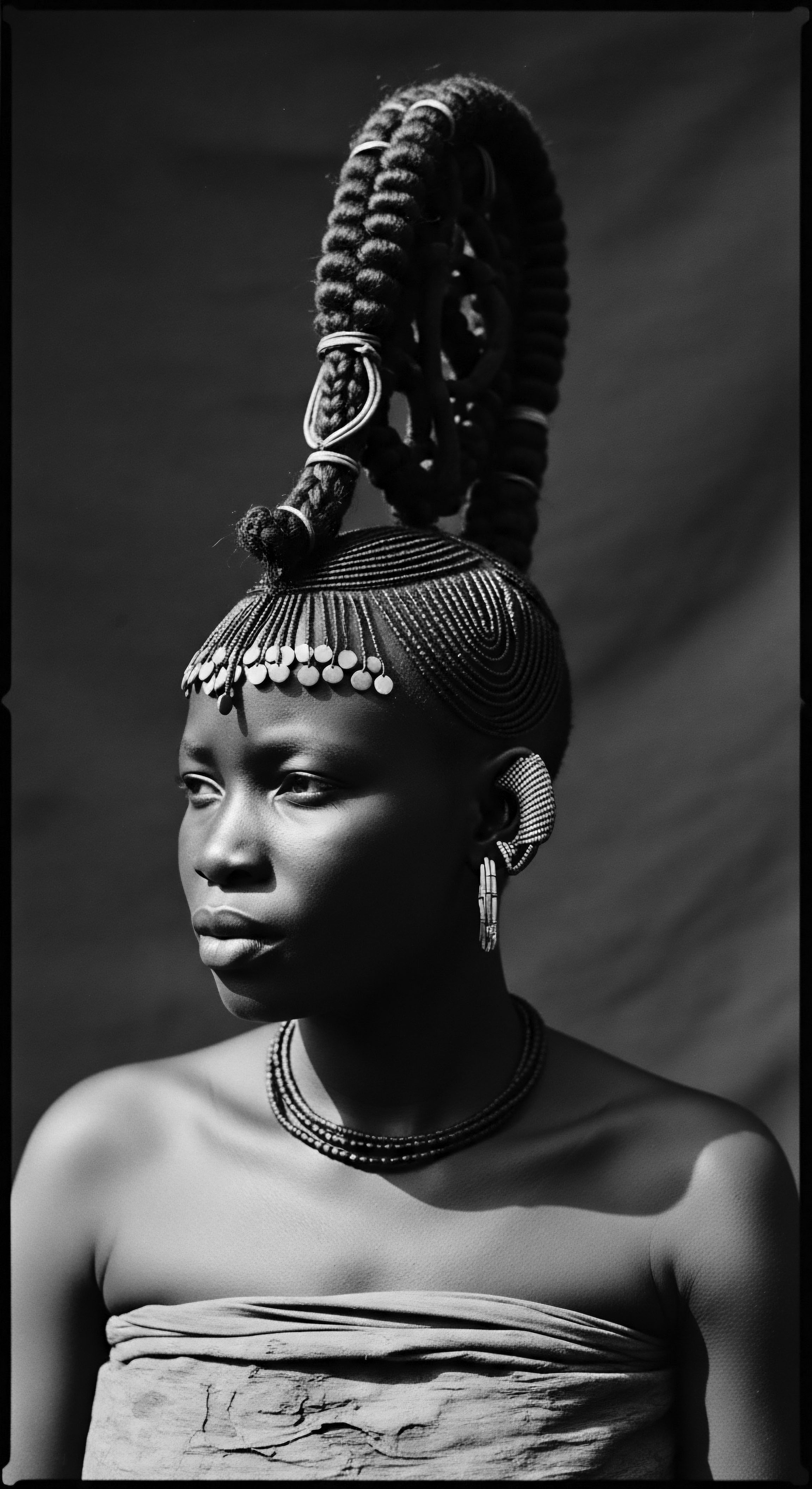
Fundamentals
The designation Behenic Acid, or docosanoic acid as it is also known, identifies a particular saturated fatty acid, a long-chain molecule comprised of twenty-two carbon atoms. This substance, appearing as a white to cream-colored crystalline powder at room temperature, holds a distinctive place within the broader classification of lipids. Its fundamental characteristic lies in its saturated nature, meaning it contains no double bonds between its carbon atoms, which imparts a certain stability and solid texture. This inherent structure is what gives Behenic Acid its valuable properties in various applications.
Historically, humanity’s interaction with substances akin to Behenic Acid predates its formal chemical naming. Ancestral communities, particularly those with deep connections to plant-based remedies and care rituals, instinctively recognized the beneficial qualities of certain natural oils and butters. These botanical treasures, often rich in long-chain fatty acids, provided lubrication, protection, and a smoothing effect on hair and skin.
The understanding of these benefits was passed down through generations, forming a living library of traditional knowledge, long before scientific inquiry isolated and named individual chemical components. The very essence of Behenic Acid, therefore, is not solely a modern scientific discovery; it is an echo of ancient wisdom, present in the very ingredients that nourished and adorned hair for centuries.
Within the realm of hair care, particularly for textured hair, Behenic Acid functions primarily as a conditioning agent. It aids in imparting smoothness, enhancing manageability, and contributing to the overall feel of the hair strand. Its molecular architecture allows it to form a protective film, helping to seal the cuticle and reduce moisture loss, a particularly significant attribute for hair types prone to dryness. This protective capacity is a key aspect of its meaning in the context of hair health.
Behenic Acid, a saturated fatty acid, offers conditioning and smoothing qualities for hair, mirroring ancestral practices that relied on natural oils rich in similar compounds.

Origins in Nature’s Bounty
Behenic Acid is not a synthetic creation; it originates naturally within specific plant oils. Among its notable sources are moringa oil , also known as ben oil, derived from the seeds of the Moringa oleifera tree, where it can constitute up to ten percent of the oil’s composition. This tree, revered across various cultures for its nutritional and medicinal value, has a history spanning millennia.
Other plant sources include rapeseed oil (canola), peanut oil , and the widely celebrated shea butter . The presence of Behenic Acid in these historically significant botanical extracts ties its contemporary scientific designation directly to a legacy of natural care.
The indigenous knowledge surrounding these plants often recognized their capacity to protect and beautify. The properties that Behenic Acid contributes—its ability to lubricate, thicken, and form a barrier—were experienced and valued through the application of these natural resources. This elemental connection between a chemical compound and the traditional practices of hair care forms the initial chapter of its story within Roothea’s living library.

Intermediate
Expanding upon its fundamental characterization, Behenic Acid holds significance as a long-chain saturated fatty acid (C22:0), valued in cosmetic formulations for its distinct textural and conditioning contributions. This chemical entity, formally termed docosanoic acid, serves as an emulsifier, thickening agent, and opacifier, lending a desirable consistency and visual appeal to products. Its molecular design, featuring a lengthy carbon chain, facilitates the creation of a protective film on the hair shaft, a quality that is particularly beneficial for textured hair. This film helps to reduce friction, enhance detangling, and impart a smooth, pliable feel, reflecting a deeper interpretation of its functional meaning.
The historical utilization of Behenic Acid, while not identified by its chemical name in earlier eras, is deeply intertwined with the use of natural oils and butters by Black and mixed-race communities. These communities, with their profound heritage of hair care, instinctively understood the emollient and protective qualities inherent in substances rich in this fatty acid. The traditional practices of applying plant-derived butters and oils to hair and scalp were, in essence, an application of Behenic Acid’s benefits, long before the advent of modern chemistry. This continuity of wisdom, spanning from ancient hearths to contemporary laboratories, speaks volumes about its enduring value.
The historical use of Behenic Acid-rich natural oils in textured hair care traditions reveals an ancestral understanding of its protective and emollient properties.

Echoes from the Source ❉ Ancestral Wisdom in Application
The enduring legacy of Behenic Acid in textured hair care finds its most profound roots in the historical and continuous use of shea butter across West and Central Africa. For thousands of years, women in these regions have processed nuts from the Vitellaria paradoxa tree to yield this rich, ivory-hued butter. Shea butter, a staple in African communities, has been applied to hair to shield it from harsh environmental elements, provide deep moisture, and promote softness.
This butter contains a notable percentage of Behenic Acid, among other beneficial fatty acids, contributing to its renowned conditioning and protective attributes. The ancestral practice of utilizing shea butter for hair care is a powerful testament to an intuitive understanding of the properties Behenic Acid offers.
Consider the meticulous, often communal, rituals of hair care in pre-colonial African societies. Hair was not merely an adornment; it served as a powerful symbol of identity, social standing, and spiritual connection. The application of natural oils and butters, such as shea, was a ceremonial act, an integral part of maintaining both physical well-being and cultural continuity. These practices implicitly leveraged the characteristics of compounds like Behenic Acid, demonstrating a deep, embodied knowledge of botanical properties.
Beyond shea butter, moringa oil , often called “ben oil” due to its Behenic Acid content (up to 10%), also holds a place in traditional African and Indian hair care. This oil was valued for its moisturizing and protective qualities, often used to add shine and reduce dryness. The stability and longevity of moringa oil, partly due to its Behenic Acid content, made it suitable for preserving other aromatic plant compounds through processes like enfleurage, highlighting its practical utility in ancient cosmetic preparations.

Traditional Preparations and Their Legacy
The preparation of these Behenic Acid-rich substances was often a labor-intensive, community-driven endeavor. For instance, the traditional process of extracting shea butter involves hand-harvesting, sun-drying, crushing, roasting, grinding, and kneading with water to separate the butter. This artisanal method, passed down through generations, ensures the purity of the product and strengthens communal bonds. The very act of preparing and applying these ingredients became a ritual, a tender thread connecting individuals to their lineage and collective wisdom.
The resilience of textured hair, particularly Black and mixed-race hair, has historically been supported by such ancestral practices. The challenges posed by environmental factors, and later, the impact of enslavement and assimilation pressures, necessitated ingenious methods of hair care. The continued use of oils and butters provided essential moisture and protection, acting as a balm for both the physical strands and the spirit. The inherent properties of Behenic Acid within these traditional preparations offered a practical solution to maintaining hair health and expressing identity, even in the face of adversity.
- Shea Butter ❉ A cornerstone of West African hair traditions for millennia, valued for its profound moisturizing and protective qualities, partially attributed to its Behenic Acid content.
- Moringa Oil ❉ Known as “ben oil” for its notable Behenic Acid levels, it was used in ancient times for its conditioning and shine-enhancing properties.
- Pracaxi Oil ❉ Originating from the Amazon, this oil possesses one of the highest concentrations of Behenic Acid (18-22%), historically applied for its emollient and hair-softening effects.

Academic
The academic delineation of Behenic Acid, or docosanoic acid (C22:0), positions it as a long-chain saturated fatty acid with a distinctive chemical composition and consequential physicochemical properties that are profoundly relevant to the domain of cosmetic science, particularly concerning hair care. Its molecular architecture, characterized by a straight chain of twenty-two carbon atoms devoid of unsaturation, confers a high melting point (approximately 80°C) and a solid, wax-like consistency at ambient temperatures. This intrinsic structural characteristic is the bedrock of its functional attributes ❉ acting as an opacifier, a viscosity-modifying agent, and an emulsifier in various formulations. The scientific interpretation of Behenic Acid extends beyond its mere presence; it involves a detailed examination of how its specific properties contribute to the efficacy and sensory experience of hair care products, especially those designed for the unique structural demands of textured hair.
From an academic perspective, the significance of Behenic Acid in hair care is multifaceted. Its capacity to form a hydrophobic film on the hair surface provides a protective barrier, mitigating moisture loss and reducing environmental aggressors. For textured hair, which often possesses a more open cuticle and is prone to dryness, this barrier function is critical for maintaining hydration and preventing breakage.
The smoothing effect observed with Behenic Acid application stems from its ability to lubricate the hair strands, thereby reducing inter-fiber friction and enhancing detangling. This chemical understanding provides a robust explanation for the observed benefits of traditional practices that utilized Behenic Acid-rich natural ingredients.
The interconnectedness between ancestral wisdom and modern scientific validation is a central tenet of Roothea’s perspective. The historical use of specific plant oils and butters, such as shea butter and moringa oil, by communities with textured hair was not a matter of chance; it was a testament to generations of empirical observation and refinement. These traditional preparations, while lacking the precise chemical nomenclature, implicitly understood the functional contributions of compounds like Behenic Acid. The scientific inquiry into these traditional ingredients now provides a deeper elucidation, confirming the efficacy of practices that have sustained hair health and cultural identity for centuries.
Academic analysis of Behenic Acid confirms its role in forming a protective film and enhancing lubrication, validating ancestral practices of applying natural oils to textured hair.

The Tender Thread ❉ Interweaving Science and Heritage
The journey of Behenic Acid from elemental biology to its role in voicing identity is perhaps best exemplified through the lens of traditional African hair care practices , particularly the widespread application of shea butter . Scientific studies have consistently characterized shea butter’s fatty acid profile, revealing significant proportions of stearic and oleic acids, alongside lesser but important amounts of palmitic, linoleic, and indeed, Behenic Acid. While Behenic Acid may not be the most abundant fatty acid in shea butter, its presence contributes to the butter’s unique semi-solid texture and its occlusive properties, which are crucial for sealing moisture into hair strands.
A powerful historical example demonstrating the intrinsic connection between Behenic Acid and textured hair heritage can be observed in the enduring tradition of hair greasing and oiling within African American communities. During the era of enslavement and its aftermath, when access to traditional African hair care practices and ingredients was severely limited or actively suppressed, enslaved and later free Black individuals ingeniously adapted available resources. Lard, butter, and various oils, which contained fatty acids akin to Behenic Acid, were employed to soften, condition, and protect hair that was often subjected to harsh conditions and minimal care. This adaptation was not merely about aesthetics; it was a profound act of self-preservation and a quiet assertion of dignity in the face of dehumanization.
The application of these greases, however rudimentary, provided a necessary barrier against environmental damage and aided in managing highly textured hair, which tends to be drier due to its coil structure and the difficulty of natural sebum traveling down the hair shaft. This practice, though born of necessity, continued for generations, evolving into the “greasing the scalp” ritual, a cornerstone of Black hair care that implicitly relied on the properties of fatty acids like Behenic Acid to maintain scalp health and hair pliability. This historical continuity underscores the substance’s profound connection to the lived experiences and ancestral ingenuity of Black people.
The academic understanding of Behenic Acid’s influence extends to its capacity to modify the rheological properties of cosmetic formulations. Its high melting point contributes to the structural integrity of balms, pomades, and solid conditioners, ensuring they remain stable at various temperatures, a practical advantage for products used in diverse climates, mirroring the adaptability required in ancestral care. Moreover, the fatty acid acts as a non-irritating ingredient that can enhance the penetration of other beneficial compounds into the hair and skin, making it a valuable component in comprehensive care systems.

Chemical Dynamics and Hair Integrity
The efficacy of Behenic Acid for textured hair types can be scientifically attributed to several key mechanisms. Firstly, its long saturated chain allows it to lay smoothly along the hair cuticle, minimizing lifted scales and creating a surface that reflects light more uniformly, resulting in enhanced shine. Secondly, its hydrophobic nature forms a protective sheath, which is particularly beneficial for hair with a higher porosity, preventing excessive water absorption and subsequent swelling, a common cause of frizz and damage in coily and curly textures. This protective action helps to preserve the hair’s internal moisture balance, which is vital for maintaining elasticity and reducing breakage.
Furthermore, Behenic Acid’s role as a conditioning agent is often synergized with other ingredients in formulations. For example, its derivative, behentrimonium methosulfate (BTMS), a quaternary ammonium compound, is widely recognized for its exceptional detangling and conditioning properties in textured hair products. While BTMS is a more complex chemical entity, its Behenic Acid backbone contributes to its ability to deposit a substantive film on the hair, offering slip and softness. This illustrates how the fundamental characteristics of Behenic Acid are amplified and adapted in modern cosmetic science to address specific hair care needs, building upon the foundational benefits observed in traditional applications.
| Traditional Ingredient/Practice Shea Butter Application ❉ Used across West Africa for centuries to moisturize and protect hair. |
| Underlying Behenic Acid Contribution Its presence contributes to the butter's emollient, film-forming, and protective qualities, helping to seal moisture into textured strands. |
| Modern Cosmetic Equivalent/Insight Emollients and occlusive agents in modern conditioners and leave-ins, offering deep hydration and cuticle smoothing for curl definition. |
| Traditional Ingredient/Practice Moringa Oil ("Ben Oil") Use ❉ Applied in various African and Indian traditions for conditioning and shine. |
| Underlying Behenic Acid Contribution High Behenic Acid content (up to 10%) contributes to its stability, moisturizing properties, and ability to impart a non-greasy feel. |
| Modern Cosmetic Equivalent/Insight Lightweight conditioning oils and serums that provide shine, reduce frizz, and protect without weighing down delicate curl patterns. |
| Traditional Ingredient/Practice Historical Hair Greasing (e.g. Lard, Butter) ❉ Practiced in the African diaspora to soften and manage hair, especially during periods of limited resources. |
| Underlying Behenic Acid Contribution Implicitly utilized the long-chain fatty acids, including those structurally similar to Behenic Acid, for lubrication, moisture retention, and protective barrier formation. |
| Modern Cosmetic Equivalent/Insight Modern hair pomades and butters formulated with specific fatty acids and waxes to provide definition, moisture, and hold for textured styles. |
| Traditional Ingredient/Practice The enduring wisdom of ancestral practices often aligns with contemporary scientific understanding, revealing a continuous thread of care for textured hair across generations. |
The analytical examination of Behenic Acid also extends to its interaction with the hair’s surface. The outermost layer of the hair, the cuticle, comprises overlapping scales. In textured hair, these scales can be more prone to lifting, leading to increased porosity and vulnerability to damage. Behenic Acid’s ability to deposit a smooth, lubricating layer helps to lay down these cuticular scales, creating a more cohesive and protected surface.
This mechanism contributes to reduced tangling, improved combability, and a noticeable enhancement in the hair’s overall appearance and tactile quality. The strategic incorporation of Behenic Acid, therefore, is not merely about adding a chemical component; it is about honoring and amplifying the hair’s natural resilience, a resilience that has been recognized and celebrated through ancestral practices for untold generations.
A deeper academic inquiry into the application of Behenic Acid within traditional hair care also considers the role of communal knowledge transfer. In many African and diasporic communities, hair care was a collective endeavor, often performed by elders or skilled practitioners who possessed an intimate understanding of hair types and the properties of natural ingredients. This embodied knowledge, passed from hand to hand, from generation to generation, ensured that the benefits of Behenic Acid-rich substances were effectively delivered. The science now deconstructs the chemical basis for these benefits, offering a bridge between the wisdom of the past and the innovations of the present.

Reflection on the Heritage of Behenic Acid
The exploration of Behenic Acid, from its molecular structure to its pervasive presence in ancestral hair care, serves as a profound meditation on the enduring wisdom embedded within textured hair heritage. It is not merely a chemical compound; it is a resonant echo of the past, a silent witness to generations of care, resilience, and identity expression. The story of Behenic Acid, particularly as it relates to Black and mixed-race hair experiences, is a testament to the ingenuity of communities who, without the lexicon of modern chemistry, instinctively understood the nourishing and protective properties of the earth’s offerings.
In the heart of Roothea’s living library, Behenic Acid stands as a symbol of continuity. Its presence in time-honored ingredients like shea butter and moringa oil speaks to an unbroken lineage of self-care, a tender thread connecting us to those who came before. These ancestors, through their hands and their hearts, cultivated a profound understanding of how to nurture hair, even in the harshest of circumstances. They recognized the softening caress of a rich butter, the protective shield of an oil, and in doing so, they implicitly understood the very qualities that Behenic Acid offers.
The significance of this fatty acid, therefore, extends beyond its scientific description. It embodies the deep sense of purpose that has always accompanied the care of textured hair – a purpose rooted in self-acceptance, cultural affirmation, and the preservation of a sacred heritage. As we continue to voice the identity of textured hair in contemporary spaces, understanding Behenic Acid allows us to honor its journey from the source, through living traditions, to its role in shaping a future where every helix is unbound, celebrated, and deeply rooted in its ancestral story.

References
- Akihisa, T. Kojima, N. Katoh, N. Ichimura, Y. Suzuki, H. Fukatsu, M. Maranz, S. & Masters, E. T. (2010). Triterpene alcohol and fatty acid composition of shea nuts from seven African countries. Journal of Oleo Science, 59 (7), 351–360.
- Akihisa, T. Kojima, N. Kikuchi, T. Yasukawa, K. Tokuda, H. Masters, E. T. Manosroi, A. & Manosroi, J. (2010). Anti-inflammatory and chemopreventive effects of triterpene cinnamates and acetates from shea fat. Journal of Oleo Science, 59 (6), 273–280.
- Gwali, S. Okullo, J. B. L. Eilu, G. Nakabonge, G. Nyeko, P. & Vuzi, P. (2011). Folk Classification of Shea Butter Tree (Vitellaria paradoxa subsp. nilotica) Ethno-varieties in Uganda. Ethnobotany Research & Applications, 9, 243-256.
- Iwu, M. M. (1993). Handbook of African Medicinal Plants. CRC Press.
- Sharaibi, O. J. Oluwa, O. K. Omolokun, K. T. Ogbe, A. A. & Adebayo, O. A. (2024). Cosmetic Ethnobotany Used by Tribal Women in Epe Communities of Lagos State, Nigeria. Journal of Complementary Medicine & Alternative Healthcare, 12 (4), 555845.
